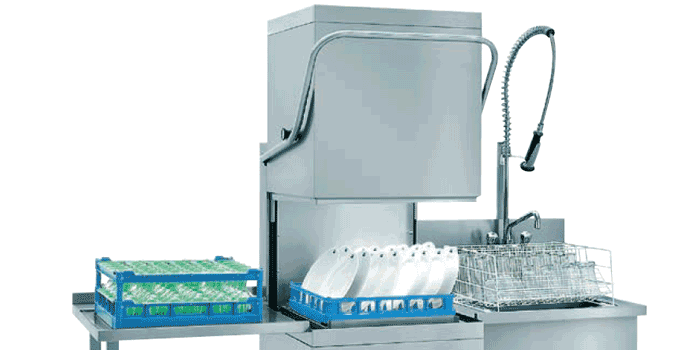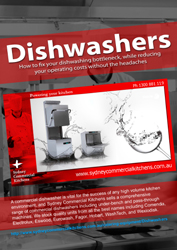Under the hood
https://uploads.prod01.sydney.platformos.com/instances/647/assets/modules/homepage/webapp_uploads/blog/images/underthehood21639948835900.png
While perhaps not the live blood of a commercial kitchen, there is no denying how important a commercial dishwasher is to the operation of a hospitality business. This FREE dishwasher guide will help you choose the correct model.
Commercial Pass-through dishwashers are also known as hood type and upright dishwashers. Typically they are floor mounted and located with stainless steel entry and exit or outlet benches either side in the dishwashing area of your kitchen. The dishwasher entry bench should have a sink located approximately 250mm outside the dishwasher. It is also a good idea to consider the use of a pre-rinse arm at this sink.
The speed of commercial units also requires a higher power input so make sure that you have the additional power available for use in your kitchen.
Covid19 has brought the importance of sanitising and hygiene to the forefront of everything we do and with dishwashing it now has an increased importance.
Sanitising and hygiene are maintained through the temperature of the water in the rinse cycle in the dishwashing program. Based on data, bacteria and germs, including coronaviruses would be almost completely killed after exposure to temperatures of 65°C (149°F) or higher for longer than 3 minutes. Rinse temperatures are generally set at 80°C and above.
Most commercial dishwashing manufacturers rely on mains pressure for the water distribution during the rinse cycle, although most of them also offer a rinse pump as an optional feature. The Smeg Professional dishwashers all have a rinse pump as standard. This feature allows for more rinse water to be distributed over the items being washed during the rinse cycle, without impacting on the amount of water used.
Currently dishwashers in Australia are also required to have a low temperature cutout switch. This means that during busier times in the kitchen, the dishwasher will continue in the wash cycle until the water has reached the required temperature for the rinse cycle to commence.
Other things to look for
When buying or replacing a pass through dishwasher there are several factors to consider. Better model dishwashers will save you money and help save the environment as well.
Water Consumption
Gone are the days when dishwashers use 7 or more litres per wash cycle. These days you should expect your dishwasher to use between 2.5 to 4.0 litres per cycle, reducing the demand on your hot water service. Make sure that you buy are-circulating style dishwasher, every manufacturer has one available.
Another way to reduce dependence on the hot water service is to buy a dishwasher fitted with Steam Heat Recovery or a Heat Condensing Unit. These dishwashers have the ability to convert cold water to hot water, typically during the wash cycle. This is a huge advantage and almost entirely reducing the cost of heating water for warewashing down to zero. The beauty of this type of dishwasher is that they can operate without the requirement of a condensation hood, which saves money for a new installation. They pay for themselves in a very short period of time.
Detergent
The less water the dishwasher uses the less the requirement for detergents, also saving you money. Also, the better the quality detergent you use, the less chemical you will use. Most manufacturers have sourced chemical detergents and rinse aids that they have determined will work best with their dishwashers.
Wash Pump Capacity
The greater the wash pump capacity the greater the ability to wash and clean your dishes .
Power Requirements
Generally upright dishwashers require a 3 phase power supply, although most manufacturers also have a model available that will operate on single phase power, usually 25 amps. An electrician will be required to upgrade the power supply and to do the appropriate power connections.
Drainage
Careful consideration should be given to the plumbing requirement of your premises. Some upright dishwashers have a gravity or overflow drain style operation although most these days are converting to the more convenient pump out style operation.
Dimensions
In the past, pass through dishwashers came in three basic sizes, small, medium and large. These days however, there are a number of imported European dishwashers on the Australian market and their sizing differs from the normal. If you are establishing a new premises this is not a problem, but if you are replacing your existing dishwasher and the sizing is different then you may be up for the cost of alterations to your stainless steel bench work.
Who uses Commercial Dishwashers
Restaurants, cafe's, clubs, takeaways, offices, canteens, school canteens, hospitality classes, kindergartens, child day care facilities, hospitals, nursing homes as well as offices.
Brands of Pass Through Dishwashers in Australia
Sydney Commercial Kitchens are able to supply dishwashers from the following brands Adler, Classeq, Comenda, Electrolux, Eswood, Fagor, Hobart, Meiko, Norris, Smeg, Washtech, Wexiodisk and Winterhalter.

Make your business our next satisfied client
If you are looking to buy equipment for your cafe or restaurant at the best price, then let us do the hard work and source the right product for your restaurant, cafe, takeaway or commercial kitchen.
Our goal at SCK is to sell you products that add value to your business.
We power your kitchen!
Sydney Commercial Kitchenshttps://uploads.prod01.sydney.platformos.com/instances/647/assets/modules/homepage/images/sck.svg?updated=1742991145
